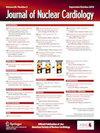Incremental prognostic value of 18F-fluorodeoxyglucose myocardial ischemic memory imaging for major adverse cardiovascular events in patients with suspected unstable angina
IF 3
4区 医学
Q2 CARDIAC & CARDIOVASCULAR SYSTEMS
引用次数: 0
Abstract
Background
The additional prognostic value of 18F-flurodeoxyglucose positron emission tomography (18F-FDG PET) myocardial ischemic memory imaging for patients with suspected unstable angina (UA) is not well established. This study aimed to determine whether 18F-FDG PET imaging provides incremental prognostic information for predicting major adverse cardiac events (MACEs) compared to clinical risk factors, Global Registry of Acute Coronary Events (GRACE) score, and coronary artery calcium score (CACS) in patients with suspected UA.
Methods
In this post hoc analysis of a prospective study, 265 patients suspected with UA (62.3% male, mean age: 65.0 ± 9.4 years) were enrolled. 18F-FDG positivity was defined as focal or focal on diffuse uptake patterns. MACEs included cardiovascular death, acute myocardial infarction, heart failure, rehospitalization for UA, and stroke. Multivariable Cox regression was used to identify predictors of MACEs, and the incremental prognostic value of 18F-FDG PET imaging was assessed using the Concordance Index (C-index), net reclassification improvement (NRI), and integrated discrimination improvement (IDI).
Results
Over a median follow-up of 25 months, 51 patients (19.2%) experienced MACEs. 18F-FDG positivity (hazard ratio [HR] = 3.220, 95% confidence interval [CI]: 1.630-6.360, P < .001), as well as 18F-FDG standardized uptake ratio (HR = 1.330, 95% CI: 1.131–1.564, P = .0006) and Extent (HR = 1.045, 95% CI: 1.028-1.062, P < .0001), were independent predictors of MACE. The addition of 18F-FDG PET imaging significantly improved risk stratification beyond clinical factors, the GRACE score, and CACS, with improved C-index (.769 vs .688, P = .045), NRI (.324, P = .020), and IDI (.055, P = .027).
Conclusion
18F-FDG PET myocardial ischemic memory imaging significantly improves prognostic assessment for patients with suspected UA, providing valuable additional risk stratification beyond clinical risk factors, GRACE score, and CACS.

18F-FDG 心肌缺血记忆成像对疑似不稳定型心绞痛患者主要不良心血管事件的增量预后价值。
背景:18F-FDG PET心肌缺血记忆成像对疑似不稳定型心绞痛(UA)患者的额外预后价值尚未完全确定。本研究旨在确定与临床风险因素、GRACE 评分和冠状动脉钙化评分(CACS)相比,18F-FDG PET 成像在预测疑似 UA 患者的主要心脏不良事件(MACE)方面是否提供了增量预后信息:在这项前瞻性研究的事后分析中,共纳入了 265 名疑似 UA 患者(62.3% 为男性,平均年龄为 65.0±9.4 岁)。18F-FDG阳性定义为局灶性或局灶性弥漫摄取模式。MACE 包括心血管死亡、急性心肌梗死、心力衰竭、UA 再住院和中风。采用多变量 Cox 回归确定 MACE 的预测因素,并使用 C 指数、净再分类改善(NRI)和综合辨别改善(IDI)评估 18F-FDG PET 成像的增量预后价值:结果:在中位 25 个月的随访期间,51 名患者(19.2%)发生了 MACE。18F-FDG阳性(HR=3.220,95%CI:1.630-6.360,P18F-FDG标准化摄取比(SUR)(HR=1.330,95%CI:1.131-1.564,P=0.0006)和Extent(HR=1.045,95%CI:1.028-1.062,P18F-FDG PET成像显著改善了临床因素、GRACE评分和CACS之外的风险分层,改善了C指数(0.769 vs 0.688,P=0.045)、NRI(0.324,P=0.020)和IDI(0.055,P=0.027).结论:18F-FDG PET心肌缺血记忆成像可显著改善疑似UA患者的预后评估,在临床危险因素、GRACE评分和CACS之外提供有价值的额外风险分层。
本文章由计算机程序翻译,如有差异,请以英文原文为准。
求助全文
约1分钟内获得全文
求助全文
来源期刊
CiteScore
5.30
自引率
20.80%
发文量
249
审稿时长
4-8 weeks
期刊介绍:
Journal of Nuclear Cardiology is the only journal in the world devoted to this dynamic and growing subspecialty. Physicians and technologists value the Journal not only for its peer-reviewed articles, but also for its timely discussions about the current and future role of nuclear cardiology. Original articles address all aspects of nuclear cardiology, including interpretation, diagnosis, imaging equipment, and use of radiopharmaceuticals. As the official publication of the American Society of Nuclear Cardiology, the Journal also brings readers the latest information emerging from the Society''s task forces and publishes guidelines and position papers as they are adopted.

 求助内容:
求助内容: 应助结果提醒方式:
应助结果提醒方式:


